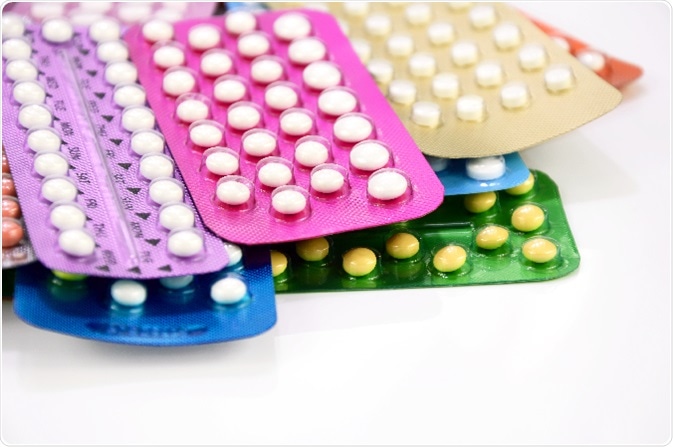For The Latest Medical News, Health News, Research News, COVID-19 News, Pharma News, Glaucoma News, Diabetes News, Herb News, Phytochemical News, Thailand Cannabis News, Cancer News, Doctor News, Thailand Hospital News, Oral Cancer News, Thailand Doctors
Contraception methods allow a couple to prevent an unwanted pregnancy. There are a number of methods that allow a couple control over their fertility. Colloquially they are called birth control measures. Different methods commonly employed by both men and women are mentioned here.

Credit: areeya_ann / Shutterstock.com
The idea of this contraceptive method is to form a barrier between the egg and the sperm so that conception via fertilization of the egg does not take place. The barrier can be used by the male or female partner. This method offers the additional benefit of preventing sexually transmitted diseases.
A male condom is a thin sheath that covers the penis and collects the sperm as it is ejaculated. The sheath is generally made of latex rubber though a lambskin alternative is available for those who have a latex allergy. They are to be disposed of after single use. Whilst the latex condoms offer some protection against sexually transmitted diseases, lambskin condoms do not.
Similar to the male condoms, the female condoms are also disposed of after a single use. They are made of plastic and are shaped like a pouch. The thin and flexible condom is inserted in the vagina before sexual intercourse.
Made of latex, the diaphragm is a shallow cup which is inserted into the vagina before sexual intercourse and blocks sperm from entering the uterus. The diaphragm needs to stay inside the vagina for 6 to 8 hours before it can be removed. It is often used in conjunction with a spermicide. In contrast to condoms, this is reusable for a year or two.
A silicone cup, quite like a diaphragm, the cervical cap is also inserted into the female’s vagina before sexual intercourse. It can be cleaned and reused for two years before it needs to be replaced. A cervical cap is often laced with a spermicide and needs to stay in place for 6 to 8 hours after intercourse to prevent pregnancy.
These are foam sponges filled with spermicide. The soft sponge is inserted into the vagina before intercourse to form a barrier against the sperm entering the uterus. The spermicide kills the sperm cells. It needs to stay in the vagina for 6 to 8 hours after intercourse to prevent pregnancy.
Hormones released into the bloodstream are responsible for directing the reproductive organs. Ovulation is a direct result of hormonal release, as is the production of sperms. If the hormones are manipulated artificially, conception will not occur.
Combined Oral Contraceptive Pills (COCs) and Progestin Only Pills (POPs) are the two most common hormone-based birth control devices. The COCs interfere with the ovulation process, while the POPs thicken the cervical mucus, thereby making it difficult for sperm to enter the fallopian tubes. Emergency Contraceptive Pills or “morning after” pills utilize a bit of both these actions to prevent conception.

Credit: areeya_ann / Shutterstock.com
It is a plastic patch that is placed on the skin and can release hormones into the bloodstream. It lasts about a week and needs to be reapplied for three weeks out of four in the month. The fourth week no patch is used to allow menstruation.
The chemical depo medroxyprogesterone acetate is an injectable birth control method. The injection is required every 3 months. Unfortunately, it has a tendency to leach calcium from bones causing loss in bone density.
This is a ring about two inches in diameter, which is inserted into the vagina. The ring is removed after three weeks for a week to allow menstruation. A new ring is inserted after 7 days. When in the vagina, the combination of synthetic estrogen and progestin that the ring releases helps prevent conception.
A matchstick-sized rod is surgically implanted under the skin of the upper arm. It releases hormones directly into the bloodstream for effective contraception. It lasts for five years.
Intrauterine Devices (IUDs) are small T-shaped objects that are implanted in the uterus by a health care provider (and removed if necessary). They can effectively prevent conception for many years.
The IUD must be inserted into the uterus by a health care provider. The copper released into the uterus by the IUD causes an inflammation reaction. This prevents the sperm from reaching the egg and, subsequently, allowing fertilization to take place. They can be used for 12 years.
The hormones released cause the cervical mucus to thicken and prevent the sperm from reaching the egg. The uterus lining is also thinned and the IUD may also prevent the release of eggs from the ovary. The hormonal IUD can be used for 5 years.
The birth control methods mentioned here are all reversible. When the couple chooses to have a child, they may discontinue the use of the contraceptive method and fertility will be restored after a period of time.